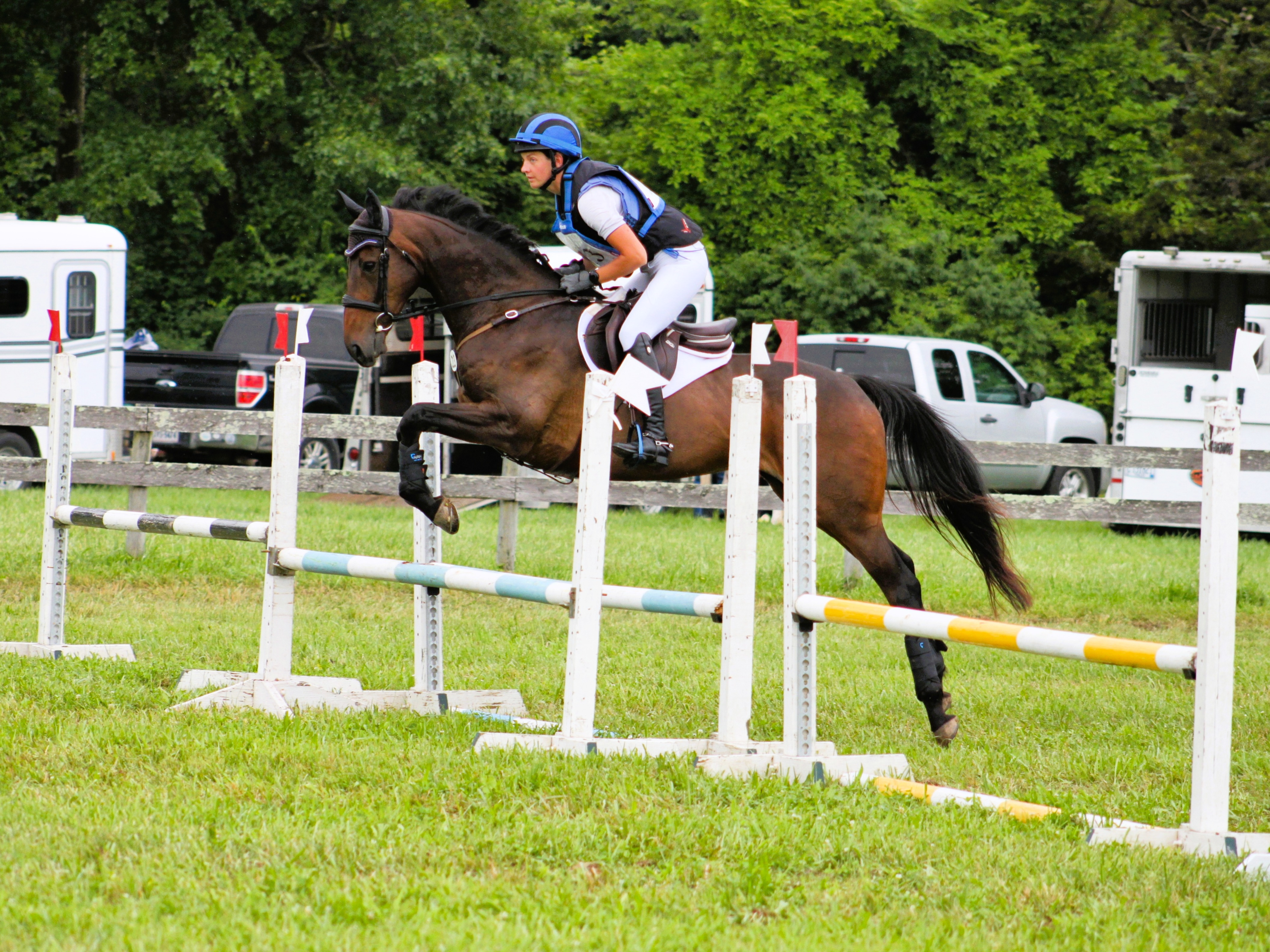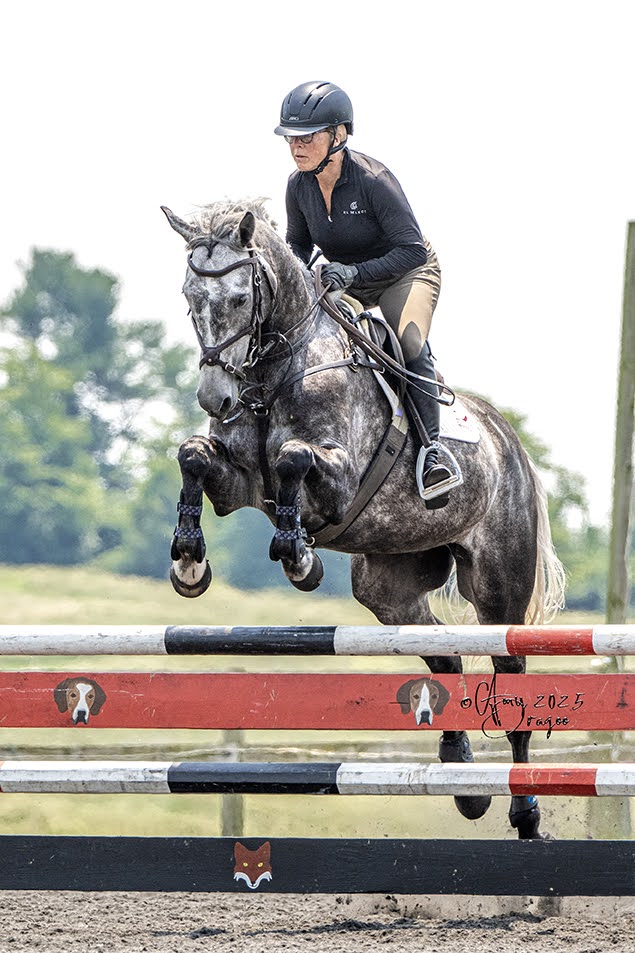 Katherine McDonough and Red. Photo by Lisa Slade.
Katherine McDonough and Red. Photo by Lisa Slade.
I am your amateur’s amateur. You know the kind. I have exactly one horse named Red who is the kindest, most perfect, patient, forgiving teacher and partner I’ve ever had, and when it’s his time to go, you better get my room in the looney bin ready because I will be in a state.
I ride purely for the fun of it surrounded by a wonderful supportive team of other amateurs doing the same as part of the Road Less Traveled Event Team, all herded and coached by Erika Adams. My lofty riding goals include completing a Novice Three-Day and achieving my Bronze Medal in dressage. I know — watch out Tokyo.
Now, while those goals would appear to be fairly attainable, you’re looking at a woman who is notoriously hard on herself –- sometimes (often times?) to the point of destruction. While friends will tell you that I can be the biggest cheerleader for them, when it comes to cheering for myself, I am the worst.
Though I have incredibly kind and supportive family and close friends, I have spent a lot of time and energy putting stock in the toxic negativity of bullies I’ve encountered all throughout my life; believing more in their measurements of me than my own. And, I have learned that when you start to accept the distortion as truth, you become the biggest bully you’ll ever encounter.

Snuggles with Red. Photo courtesy of Katherine McDonough.
So, where is this going? Several weeks ago I had an ah-ha moment in my dressage lesson. But it wasn’t just an ah-ha for riding, but also for my life. I know, sounds a bit melodramatic. But, stay with me.
I have been struggling in my flatwork going to the left in all gaits and movements recently. I hit the peak of this frustration in my lesson with Erika and expressed it in a, typical for me, word vomit of self-deprecation. “Ugh I’m so annoyed! I’m so good to the right — my hands and arms do what they are supposed to do. And then I go to the left and I’m so bad! My left arm is just worthless and everything falls apart! Red doesn’t know what I’m asking and it just gets worse and worse. My right arm is so good and strong and my left arm is useless and weak!”
Erika let this abusive word vomit subside, looked at me, and calmly said, “Your left arm isn’t weak and useless. It’s actually strong and good at its job.” To which I gave her a yeah-right-you’re-just-trying-to-make-me-feel-better-nice-try eyeroll.
But, undeterred, she continued. “It IS. We have evolved to have one side of us be our stability and one side be dexterous. One side holds us firmly and steadily to the tree trunk high above the ground, and the other side reaches out and carefully picks the fruit. Your left arm isn’t weak. It’s really good at being the strong stable one — the steady outside rein. And your right arm is really good at picking the fruit — making the tiny changes on the inside rein. You’re not struggling to the left because your left arm is weak and useless. It’s because your left arm has a hard time picking the fruit and your right arm struggles to hold steady to the tree.”
And suddenly, it all became clear, and my dressage has been completely different ever since. Yes, my inability to make my arms and hands do the right thing was a training issue. But the way I was handling it was a perspective issue.

Successfully cantering a circle to the left in a lesson this past weekend. Photo by Lisa Slade.
There was something in the way Erika explained it that day — she didn’t just tell me “Yes you can,” like a band-aid. She held a simple and genuine truth up in front of me, and helped me realize that my perspective was keeping me from figuring it out. The ability to fix my arms was within me the whole time; I just had to be willing to lay down my weapons and see it.
I was immediately able to forgive my left arm: to cut it, and myself, some slack. It’s not weak or useless or an alien appendage. It’s really good at being strong and steady. I was able to explain to myself what I needed my arms to do when going to the left. You see, when I quit hating my arms for being bad, and acknowledged them for their strengths, I began to ride better.
That moment in my lesson hasn’t left me, and I have thought about it every day since. I have spent a lot of my life feeling like I was or too much or not enough — too tall, not smart enough, too overweight, too loud, not ladylike enough, too single, too sensitive, not pretty enough, too impulsive — because at one point or another someone said it to me and I took it as truth. This negative self-image has (unsurprisingly) infiltrated my riding. But suddenly, like a switch, things changed.
I have carried this weight — this verbally abusive version of myself who has evolved and grown inside of me — for years. From my riding life to personal life, the negativity has always been with me, ready to spring into action and steal away something good.
And the worst part is that I kept feeding it. Tell me I look nice and I’ll immediately point out how I don’t. Compliment my work and I’ll shoot it down. Admire my riding and I’ll say how bad it is. Why couldn’t I just say, “Thank you?” Why couldn’t I just tell myself the words I’d heard two decades ago or even two years ago were nonsense and move on on my own?

Katherine and Red cross country schooling. Photo by Kaylen Moon.
A popular theory out there suggests that once we love and accept ourselves, everything else will follow. I would argue that actually you need people in your life who help you find yourself when you’ve lost your bearings. These friends (family, teachers, coaches, mentors) aren’t afraid to hold up a mirror and tell you when you’re being too big for your britches. But they also help you restore the distorted image you have of yourself. I think that sometimes it’s harder to accept yourself on your own — you need honest people around you to reflect it back at you so you can see that it’s real.
What was so profound about that moment in my lesson was that I wasn’t just able to fix the way I ride to the left. I was able to reject the abuser inside of me. Now when Erika says that something was good, I take it in and feel it instead of rejecting it. When I finish a course or take a walk break in a flat lesson, I make a point of acknowledging the things I liked about the work first. And when I do talk about what wasn’t so great, I make an effort not to be unreasonably hard on myself. And, amazingly, this new perspective has begun to extend to my life outside of the barn as well.
What I’m trying to say is this: we know that eventing is not a sport done alone, but it’s even harder to do when you keep feeding that pile of hurtful words on your back. And that stuff you carry around goes with you everywhere — from home to work to dinner with friends. And yes, it trickles into your time in the tack.
But what I’ve learned is that when you can shake loose that mountain of negativity you’ve allowed yourself to carry all of those years, that will trickle into your riding too. Sometimes you don’t realize that scars from years ago are keeping you from trotting a nice circle to the left.

Erika coaching members of the RLT team at a schooling day at River Glen. Photo by Katherine McDonough.
But perhaps most importantly, try to find the people who don’t just help you achieve your goals, but the people who help you help yourself achieve them. After all — at the show your coach can’t trot the circles with you, and she can’t jump the jumps with you. So why would you want all of that negativity out there interfering with you instead? It has no business being there, because ultimately, eventing is between you, your horse, and the course.
Go you. Go Eventing.














































